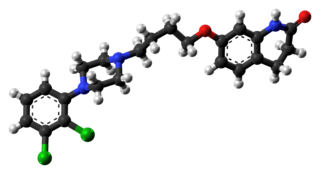
Aripiprazole, sold under the brand names Abilify and Aristada, among others, is an atypical antipsychotic. It is primarily used in the treatment of schizophrenia, obsessive compulsive disorder (OCD), and bipolar disorder; other uses include as an add-on treatment in major depressive disorder, tic disorders, and irritability associated with autism. Aripiprazole is taken by mouth or via injection into a muscle. A Cochrane review found low-quality evidence of effectiveness in treating schizophrenia.

Fingolimod, sold under the brand name Gilenya, is an immunomodulating medication, used for the treatment of multiple sclerosis. Fingolimod is a sphingosine-1-phosphate receptor modulator, which sequesters lymphocytes in lymph nodes, preventing them from contributing to an autoimmune reaction. It has been reported to reduce the rate of relapses in relapsing-remitting multiple sclerosis by approximately one-half over a two-year period.

Cladribine, sold under the brand name Leustatin, among others, is a medication used to treat hairy cell leukemia and B-cell chronic lymphocytic leukemia. Cladribine, sold under the brand name Mavenclad, is used for the treatment of adults with highly active forms of relapsing-remitting multiple sclerosis.

Celgene Corporation is a pharmaceutical company that makes cancer and immunology drugs. Its major product is Revlimid (lenalidomide), which is used in the treatment of multiple myeloma, and also in certain anemias. The company is incorporated in Delaware, headquartered in Summit, New Jersey, and a subsidiary of Bristol Myers Squibb (BMS).
Multiple sclerosis (MS) is a chronic inflammatory demyelinating disease that affects the central nervous system (CNS). Several therapies for it exist, although there is no known cure.
Sphingosine-1-phosphate (S1P) is a signaling sphingolipid, also known as lysosphingolipid. It is also referred to as a bioactive lipid mediator. Sphingolipids at large form a class of lipids characterized by a particular aliphatic aminoalcohol, which is sphingosine.
Ustekinumab, sold under the brand name Stelara among others, is a monoclonal antibody medication developed by Janssen Pharmaceuticals, for the treatment of Crohn's disease, ulcerative colitis, plaque psoriasis and psoriatic arthritis, targeting both IL-12 and IL-23.

Sphingosine-1-phosphate receptor 5 also known as S1PR5 is a human gene which encodes a G protein-coupled receptor which binds the lipid signaling molecule sphingosine 1-phosphate (S1P). Hence this receptor is also known as S1P5.

Muraglitazar is a dual peroxisome proliferator-activated receptor agonist with affinity to PPARα and PPARγ.
Arena Pharmaceuticals, Inc. is an American biopharmaceutical company founded in 1997 and headquartered in San Diego, California. The company has small molecule drugs in development for possible clinical utility in multiple therapeutic areas. The company's most advanced investigational clinical programs are ralinepag in testing for pulmonary arterial hypertension (PAH), etrasimod in evaluation for inflammatory indications and APD371 for the treatment of pain associated with Crohn's disease. In 2016, the company downsized and shifted its focus to developing new drugs currently being tested in clinical trials. In December 2021, Pfizer announced that it had agreed to acquire Arena for $6.7 billion in cash. In March 2022, it was announced the acquisition by Pfizer had been concluded.

The sphingosine-1-phosphate receptors are a class of G protein-coupled receptors that are targets of the lipid signalling molecule Sphingosine-1-phosphate (S1P). They are divided into five subtypes: S1PR1, S1PR2, S1PR3, S1PR4 and S1PR5.

′

Juno Therapeutics Inc was an American biopharmaceutical company founded in 2013 through a collaboration of the Fred Hutchinson Cancer Research Center, Memorial Sloan-Kettering Cancer Center and pediatrics partner Seattle Children's Research Institute. The company was launched with an initial investment of $120 million, with a remit to develop a pipeline of cancer immunotherapy drugs. The company raised $300 million through private funding and a further $265 million through their IPO.

Siponimod, sold under the brand name Mayzent, is a selective sphingosine-1-phosphate receptor modulator for oral use that is used for multiple sclerosis (MS). It is intended for once-daily oral administration.
There are several ways for pharmaceuticals for treating multiple sclerosis (MS) to reach the market.

Sphingosine-1-phosphate receptor modulators are a class of drugs used as immunomodulators, most notably in cases of multiple sclerosis.
Bempegaldesleukin (development code NKTR-214) is an experimental anti-cancer drug candidate. It is a PEGylated interleukin-2 (IL-2) acting as a CD122-preferential IL-2 pathway agonist designed to activate and proliferate CD8+ T cells and NK cells. It is being developed by Nektar Therapeutics.
Idecabtagene vicleucel, sold under the brand name Abecma, is a cell-based gene therapy to treat multiple myeloma.
Edward Roberts FRSC., is a British-born American scientist with expertise in biochemistry and synthetic organic chemistry. He is recognized for his significant contributions to medicinal chemistry, the design and discovery of new medicines in the development of novel therapeutics.

Etrasimod, sold under the brand name Velsipity, is a medication that is used for the treatment of ulcerative colitis (UC). It is a selective sphingosine-1-phosphate (S1P) receptor modulator that modifies the activity of the immune system. It is taken by mouth.













